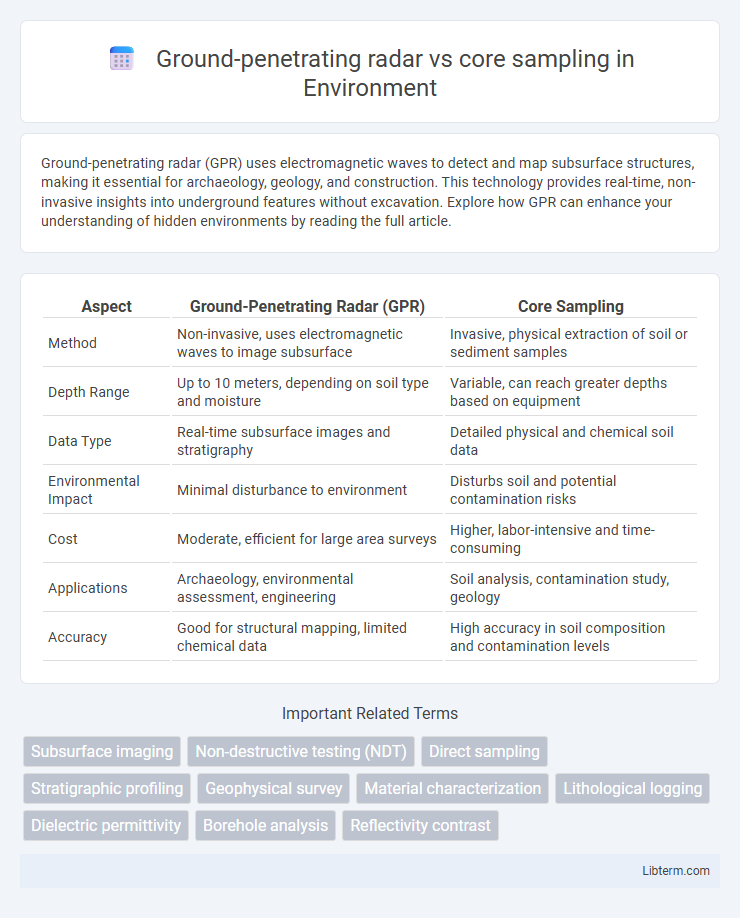Ground-penetrating radar (GPR) uses electromagnetic waves to detect and map subsurface structures, making it essential for archaeology, geology, and construction. This technology provides real-time, non-invasive insights into underground features without excavation. Explore how GPR can enhance your understanding of hidden environments by reading the full article.
Table of Comparison
| Aspect | Ground-Penetrating Radar (GPR) | Core Sampling |
|---|---|---|
| Method | Non-invasive, uses electromagnetic waves to image subsurface | Invasive, physical extraction of soil or sediment samples |
| Depth Range | Up to 10 meters, depending on soil type and moisture | Variable, can reach greater depths based on equipment |
| Data Type | Real-time subsurface images and stratigraphy | Detailed physical and chemical soil data |
| Environmental Impact | Minimal disturbance to environment | Disturbs soil and potential contamination risks |
| Cost | Moderate, efficient for large area surveys | Higher, labor-intensive and time-consuming |
| Applications | Archaeology, environmental assessment, engineering | Soil analysis, contamination study, geology |
| Accuracy | Good for structural mapping, limited chemical data | High accuracy in soil composition and contamination levels |
Introduction to Subsurface Investigation Techniques
Ground-penetrating radar (GPR) offers a non-invasive method to detect subsurface features by emitting electromagnetic waves and analyzing their reflections, providing real-time imaging of soil stratigraphy and buried objects. Core sampling involves extracting soil or rock samples physically, enabling detailed laboratory analysis of material composition, strength, and contamination levels. Both techniques complement each other in subsurface investigation, with GPR excelling in rapid surveying and core sampling delivering precise, localized geotechnical data.
Overview of Ground-Penetrating Radar (GPR)
Ground-penetrating radar (GPR) uses high-frequency radio waves to create subsurface images, enabling non-invasive detection of underground structures and materials. Unlike core sampling, which involves physical extraction of soil or rock samples, GPR provides real-time, continuous data over large areas with minimal disturbance to the site. Its effectiveness depends on soil composition, moisture content, and depth, making it ideal for geotechnical surveys, archaeology, and environmental studies.
Fundamentals of Core Sampling Methods
Core sampling involves extracting cylindrical sections of subsurface materials to analyze soil composition, stratigraphy, and contaminant presence, providing direct physical evidence. Ground-penetrating radar (GPR) utilizes electromagnetic waves to non-invasively image subsurface features, offering rapid spatial data but less precise material characterization. Understanding core sampling fundamentals, including selection of appropriate coring tools, maintaining sample integrity, and precise depth targeting, ensures accurate geological and environmental assessments unmatched by GPR's indirect imaging.
Technology Comparison: GPR vs Core Sampling
Ground-penetrating radar (GPR) employs electromagnetic waves to create subsurface images, enabling non-invasive detection of soil layers, utilities, and buried objects with rapid data acquisition. Core sampling physically extracts soil or rock samples, providing direct material analysis and precise stratigraphic information but requires labor-intensive drilling and can be time-consuming. GPR is preferred for large-area surveys and real-time mapping, while core sampling offers detailed, ground-truth data critical for geotechnical and environmental assessments.
Accuracy and Reliability in Subsurface Analysis
Ground-penetrating radar (GPR) offers high-resolution imaging for subsurface analysis, enabling accurate detection of buried objects and stratigraphy in non-destructive ways, but its reliability can be impacted by soil moisture, composition, and depth limitations. Core sampling provides direct physical evidence by extracting subsurface materials, delivering highly reliable and precise data on geological, chemical, and structural properties, though it is invasive and limited in spatial coverage. Combining GPR with core sampling enhances accuracy and reliability by correlating electromagnetic data with physical samples, optimizing comprehensive subsurface characterization.
Data Collection and Interpretation Differences
Ground-penetrating radar (GPR) collects continuous subsurface images by transmitting electromagnetic waves and analyzing their reflections, providing real-time data that reveals soil composition and underground structures without excavation. Core sampling involves extracting physical soil or rock samples to obtain precise material properties and stratigraphic information, allowing detailed laboratory analysis but offering discrete data points limited to the sampled locations. Interpretation of GPR data relies on signal wave patterns and requires expertise in geophysical analysis, while core sample results provide direct physical evidence, making it easier to validate geological conditions with tangible material characteristics.
Cost and Efficiency Considerations
Ground-penetrating radar (GPR) offers a cost-effective and non-invasive approach for subsurface investigation, enabling rapid data collection with minimal site disruption compared to core sampling. Core sampling involves higher labor and material costs due to the extraction and laboratory analysis of physical samples, but provides highly accurate and detailed geological information. Efficiency considerations favor GPR for large-area surveys with quick results, while core sampling is preferred for precise, localized assessments despite longer project timelines.
Environmental Impact and Site Disturbance
Ground-penetrating radar (GPR) offers a non-invasive approach to subsurface investigation, minimizing environmental impact and reducing site disturbance compared to core sampling, which physically extracts soil or sediment samples and can disrupt natural habitats. GPR uses electromagnetic waves to create detailed images of subsurface features, allowing for rapid and environmentally sensitive assessments without soil removal. Core sampling, while providing precise soil composition data, has a higher potential for contamination and habitat disruption due to drilling and extraction processes.
Applications and Industry Use Cases
Ground-penetrating radar (GPR) is widely used in construction and archaeology for non-invasive subsurface imaging, enabling rapid detection of utilities, voids, and structural elements without excavation. Core sampling remains the industry standard in geology and environmental science for obtaining precise soil, rock, and sediment profiles critical for resource exploration and contamination analysis. Both technologies complement each other in infrastructure assessment, with GPR providing spatial mapping and core sampling delivering detailed material composition for accurate decision-making.
Choosing the Right Method: Factors to Consider
Choosing between ground-penetrating radar (GPR) and core sampling depends on project objectives, site conditions, and desired data resolution. GPR offers non-destructive subsurface imaging ideal for rapid surveys and detecting utilities or voids, while core sampling provides precise, physical soil or material analysis crucial for geotechnical or environmental assessment. Budget constraints, depth of investigation, and required data accuracy are critical factors influencing the optimal geophysical or direct sampling method.
Ground-penetrating radar Infographic

 libterm.com
libterm.com